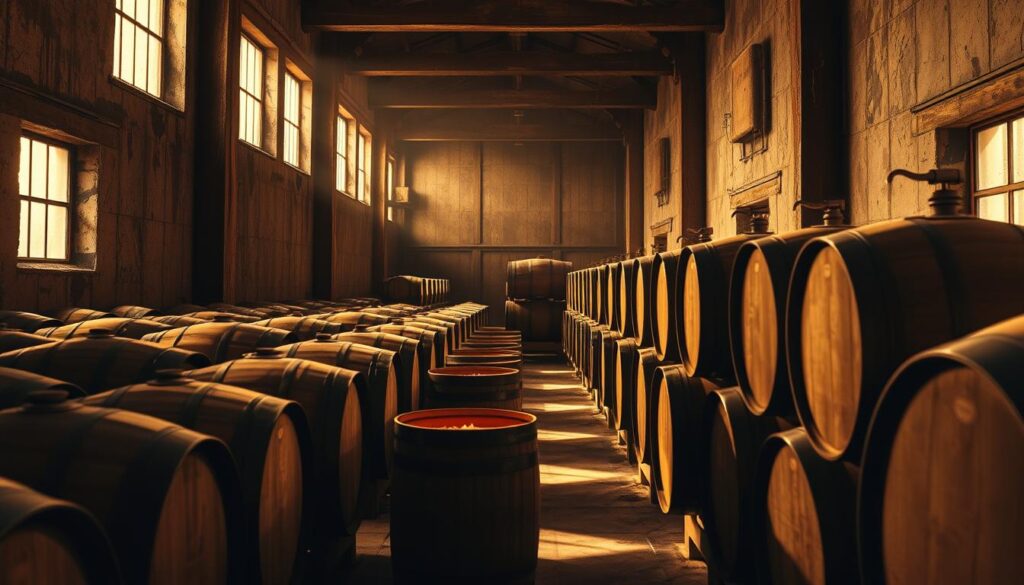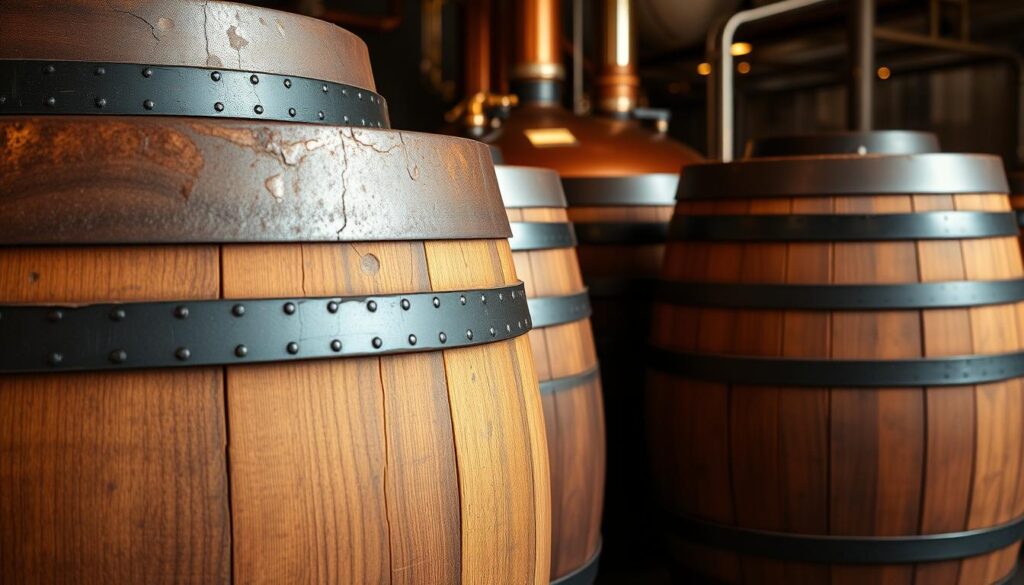Ever wonder about the whiskey bottles per barrel? It’s a fascinating question that delves into the heart of whiskey production. Every sip of whiskey carries the story of its journey from the barrel to the bottle. Understanding how many bottles emerge from a single barrel unveils secrets of distillation, aging, and craftsmanship.
The standard whiskey barrel volume plays a crucial role in determining the yield, but it’s not the only factor at play. Evaporation, known as the “angel’s share,” and the unique shape of each barrel add layers of intrigue to this age-old process.
So, just how much whiskey does a barrel truly hold? Let’s uncork the mystery!
Understanding Whiskey Barrel Sizes
Whiskey barrel size is very important in making and aging whiskey. The American Standard Barrel (ASB), also known as the Bourbon barrel, is the most common. It holds 53 US gallons (200 liters), which is the standard for most distilleries.
Before World War II, whiskey barrels were 48 gallons. However, during the war, material shortages led to bigger 53-gallon barrels. This change helped distilleries use fewer barrels. Now, one ASB can make 250 to 300 standard 750ml bottles of whiskey.
Craft distilleries might use smaller barrels to make whiskey taste faster. The barrel size affects the whiskey’s taste, as seen in American whiskey styles. Smaller barrels mean more wood contact, which can make whiskey taste over-oaked quickly.
But, larger barrels take longer to add flavor, making the whiskey more balanced and complex. Knowing about whiskey barrel sizes helps us better understand whiskey-making.
Types of Whiskey Barrels
The size and type of whiskey barrel play a crucial role in aging and flavor development. Here’s an overview of common barrel types and their impact:
- Bourbon Barrels: These 53-gallon barrels, made from American oak, are widely used to age whiskey. They impart strong vanilla and spice flavors early in the aging process.
- Scotch Whisky Barrels: Often crafted from ex-bourbon or European oak, these barrels contribute distinct flavors. European oak, for instance, adds rich, tannic notes.
- Hogsheads: Hogshead barrels, with a capacity of about 250 liters, commonly serve in whiskey production. They offer a balance of volume and flavor impact.
- Quarter Casks: These smaller barrels, holding around 125 liters, accelerate the aging process due to greater wood-to-whiskey contact, resulting in bold and complex flavors.
- First-Fill Barrels: These barrels, used for the first time, retain residue from their previous contents, enhancing the whiskey’s depth and character.
- Second-Fill Barrels: Ideal for longer aging (10 years or more), these barrels produce a subtler wood influence, allowing other flavors to shine.
- Multiple-Use Barrels: Reused barrels create more delicate and nuanced whiskey, as the wood’s intensity diminishes with each use.
- Specialty Finishes: Barrels that previously held Pedro Ximénez, Port, or Tawny contribute unique finishing notes, such as sweetness, dried fruit, or nuttiness.
Variations in Barrel Types
Whiskey barrel size is key in aging. While the standard is 53-gallon barrels, many try different sizes. Craft makers use smaller barrels to age whiskey faster.
These smaller containers have more surface area. This means the whiskey absorbs flavors quicker, making it taste bolder. Larger barrels, however, age whiskey slower. This results in smoother and more balanced flavors.
The size of the barrel affects how many bottles you can make. A standard bourbon barrel can fill about 150 to 200 750ml bottles. Smaller barrels make fewer bottles but can add flavor faster.
Distilleries also experiment with different barrel types to create unique whiskeys. They might use rum, wine, or exotic wood barrels, and the type of wood greatly changes the whiskey’s taste.
For example, American oak gives bourbon a sweet vanilla taste. European oak, used for Scotch, adds tannic and spicy notes. These differences let distillers create distinct whiskeys, each with its own taste.
Conversion From Barrel to Bottles
The process of converting whiskey barrels into bottles is fascinating. A standard whiskey barrel holds about 53 gallons, which translates to roughly 267 bottles of 750 milliliters each. However, the number of bottles per barrel can vary due to factors like aging, cask type, and proofing.
For bourbon aged 4-6 years, you may get 160-180 bottles before proofing, and 220-240 bottles after proofing. Aging reduces the liquid volume due to evaporation, known as “the angel’s share.”
The type of cask also influences yield. A quarter cask produces about 66 bottles, while a port pipe cask can yield 733-866 bottles. Bottling proof impacts the total as well — higher proof results in fewer bottles. Diluting to a lower proof increases yield, sometimes exceeding 200 bottles per barrel.
Kentucky exemplifies the scale of whiskey production, with over 7.5 barrels for every 4.5 million residents. This highlights the importance of efficient barrel-to-bottle conversion.

Factors Affecting Yield
The yield of whiskey from a barrel depends on several factors, starting with the barrel size. A standard American whiskey barrel holds 53 gallons, which can produce about 266 bottles of 750 ml each. However, this number varies due to several considerations:
- The Angel’s Share: Evaporation during aging is a major factor. On average, 2% of the whiskey evaporates each year. Climate, temperature, and rickhouse conditions significantly influence this loss. Longer aging periods increase evaporation, reducing the final yield.
- Barrel Size and Type: Smaller barrels, like quarter casks (50 liters), produce fewer bottles than larger ones like hogsheads (240 liters). Additionally, the type of barrel — whether used for bourbon, sherry, or another purpose impacts both flavor and volume.
- Dilution and Bottling: Whiskey bottled at cask strength yields fewer bottles than whiskey diluted to standard bottling proof, typically 40-46% ABV. Dilution can increase the total number of bottles but alters the product’s strength.
Distilleries generally estimate between 200 and 300 bottles per barrel, accounting for these variables. These factors are critical in determining the final yield of aged whiskey.

Distillation and Aging Process
Whiskey aging in barrels is crucial for developing its complexity and flavor. After distillation, distillers place the spirit into barrels. Bourbon must age for at least two years in new, charred American White Oak barrels, a requirement that defines it as bourbon.
During aging, whiskey absorbs flavors and colors from the wood, a process that can last from two years to several decades. Bourbon typically ages for 4-6 years, while Scotch and Irish whiskeys often age longer. During aging, whiskey evaporates, a phenomenon known as the “angel’s share.”
Temperature fluctuations cause barrels to expand and contract, influencing how the whiskey interacts with the wood. New Riff uses a number 4 char, achieved by flaming barrels for 55 seconds, which impacts flavor. Distillers typically barrel whiskey at 110-125 proof, the legal limit for bourbon (62.5% alcohol by volume).
Whiskey Production Around the World
Whiskey making varies across the globe, with each area having its own traditions and rules. Kentucky is a big name in whiskey, especially bourbon. Its climate is perfect for aging bourbon, bringing out deep flavors.
Whiskey makers fill over 2.7 million barrels of bourbon every year, setting new production records. Kentucky has over 12.6 million aging barrels of bourbon and spirits — more than two barrels for each resident.
This strong whiskey-making helps Kentucky’s economy a lot. It’s worth $9 billion and creates over 23,100 jobs.
But Kentucky isn’t the only place making whiskey. Scotland, Ireland, Japan, and Canada are also famous for it. Each place’s climate, traditions, and rules affect how they age whiskey. This leads to different tastes and amounts in bottles.
This variety in whiskey-making shows how versatile and important it is around the world.
Fun Facts About Whiskey Barrels
Whiskey barrels are an essential part of crafting the flavors and aromas we enjoy in every glass. From their construction to their use in aging, barrels play a fascinating role in the whiskey-making process. Let’s look at some intriguing facts about these vital tools of the trade.
- Whiskey barrels play an essential role in shaping the whiskey’s taste and character during aging.
- By law, whiskey makers use new, charred oak barrels to create bourbon’s unique flavor profile.
- Barrel makers source wood from northern U.S. regions, where cooler climates produce denser wood ideal for aging whiskey.
- Barrel makers reduce the wood’s water content from 60% to about 12% before crafting the barrels.
- Distilleries like Angel’s Envy apply a #3 char, involving a 35-second burn inside the barrel, to enhance flavor.
- Scotch whisky producers age their spirits in used bourbon barrels, which add unique flavors while lowering costs.
- Whiskey makers use barrels of various sizes, from quarter casks holding 125-130 liters to puncheon casks holding up to 550 liters.
- Experts estimate that barrels influence 70-80% of a whiskey’s final character.
- Distilleries use fresh-fill and second-fill casks to impart distinct nuances, enhancing the whiskey’s complexity.
- Whiskey producers worldwide rely on diverse barrel types, from new oak to reused bourbon casks, to craft unique flavors.
Final Thoughts: Unlocking the Mystery of Whiskey Barrels
The journey from barrel to bottle is a story of craftsmanship, patience, and a touch of nature’s unpredictability. Each bottle represents years of aging, careful monitoring, and the unique interplay between wood and spirit. From the “Angel’s Share” to proofing, every step shapes the whiskey’s final flavor and character in your glass.
But whiskey isn’t just about numbers — it’s about the experience. Whether savoring a cask-strength pour or a proofed favorite, the story of the barrel enriches every sip. Understanding these details adds depth to your appreciation and connects you to the centuries-old traditions behind this iconic spirit.
Craving more insights into the world of whiskey? From rare Scotch gems to expert pairing tips, uncover the secrets of Scotland’s finest whiskies. Visit Scotland Whisky and elevate your whiskey journey today!